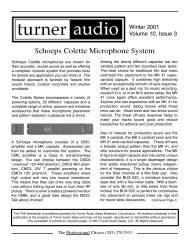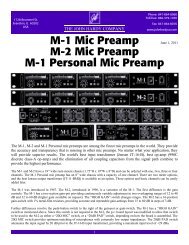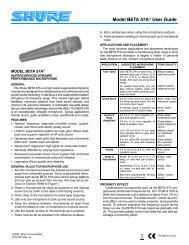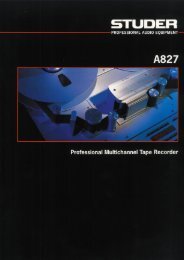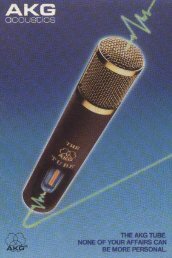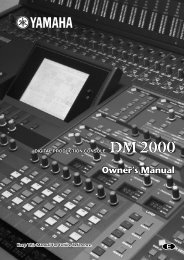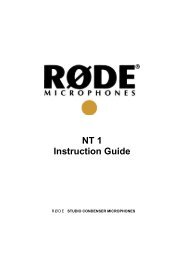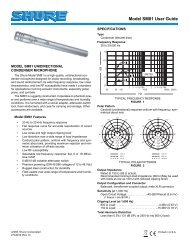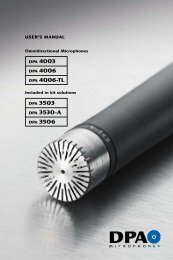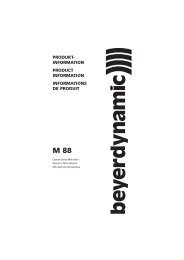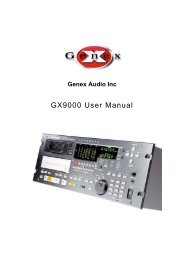Lexicon 480L | PDF - Freeverb3
Lexicon 480L | PDF - Freeverb3
Lexicon 480L | PDF - Freeverb3
You also want an ePaper? Increase the reach of your titles
YUMPU automatically turns print PDFs into web optimized ePapers that Google loves.
<strong>Lexicon</strong> <strong>480L</strong> Owner's Manual<br />
Control Mode - Reference Section<br />
The following list contains a brief description of every<br />
parameter in the control mode, listed in order by page<br />
number.<br />
Page One<br />
STA (Status)<br />
Moving the STA slider displays the current status of a<br />
variety of different controls on the <strong>480L</strong>. This control<br />
doesn't permit you to change any settings—it simply<br />
allows you to quickly check out the status of several<br />
<strong>480L</strong> controls.<br />
CFG (Configuration)<br />
The <strong>480L</strong> can run any two of its programs simultaneously.<br />
The two programs can be used independently,<br />
or they can be connected together internally in any of<br />
several configurations. The CFG control is used to<br />
choose one of these configurations.<br />
SMP (Sampling Rate)<br />
SMP selects between 44.1 kHz and 48 kHz sampling<br />
rate. Use the higher 48 kHz sampling rate for maximum<br />
audio performance. However, when using digital I/O,<br />
the 44.1 kHz rate may be required to match an external<br />
device.<br />
CLK (Clock Source)<br />
The <strong>480L</strong> can generate its own word clock, or it can be<br />
slaved to 48 kHz, 44.1 kHz, and 44.056 kHz external<br />
word clocks (through the digital I/O connector). For<br />
most applications using the <strong>480L</strong>'s analog inputs, CLK<br />
should be set to INTERNAL. For most digital I/O<br />
applications, CLK should be set to EXTERNAL. If<br />
EXTERNAL is selected, but an external word clock is<br />
not present at the digital I/O connector, the <strong>480L</strong> will<br />
continue to use its internal word clock.<br />
To determine if the <strong>480L</strong> is correctly receiving an<br />
external word clock, move the STATUS slider (slider<br />
one, page one) to display External Word Clock Status.<br />
Important! Do not send external word clock<br />
to the <strong>480L</strong> until after it is powered up.<br />
INP (Input Source)<br />
INP chooses between analog audio input via the main<br />
inputs and digital audio input via the digital I/O port.<br />
Page Two<br />
Page 2 contains controls related to copying and moving<br />
registers. It is sometimes referred to as the register<br />
transporter page.<br />
FUN (Function Setup)<br />
The FUN slider has eight functions:<br />
• COPY SETUP<br />
• INT TO CART<br />
• CART TO INT<br />
• MOVE SETUP<br />
• CLR SETUP<br />
• CLR ALL INT<br />
• CLR ALL CART<br />
• FORMAT CART<br />
• DUMP<br />
COPY SETUP copies a program or register to a specified<br />
register location<br />
INT TO CART copies all the registers in internal<br />
memory to the cartridge<br />
CART TO INT copies all the registers in the cartridge to<br />
internal memory<br />
MOVE SETUP copies a register to a specified register<br />
location, and deletes the original.<br />
CLR SETUP deletes the specified register<br />
CLR ALL INT clears all internal registers<br />
CLR ALL CART clears all registers in the cartridge<br />
FORMAT CART formats the cartridge<br />
DUMP allows MIDI tranmission of Automation data.<br />
To perform any of these functions, hold down STO and<br />
press REG.<br />
SRC (Source)<br />
SRC selects the source register or program for clearing,<br />
moves or copies.<br />
DST (Destination)<br />
DST selects the destination register for copies or<br />
moves.<br />
E-2


